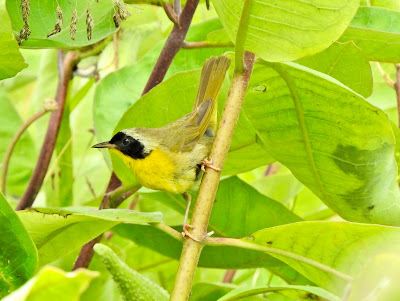8-9-21 VERMONT: Time slides by. It’s been over a week without a post or without any rain. We’ve gone from too wet to too dry. The ponds are still full and draining, and the ground hasn’t dried out yet. The days are noticeably shorter, but hot, we’ve been in the eighties almost every day.
We put up an owl nesting box behind the pond on one of the big pines. Now I know that they’re not going to raise new chicks at this point in the season, but it has to go up at some point and will be ready for next year. I had help from Cory, Val and Lucy, and Judy supplied commentary and cautions. It’s actually pretty high up the tree.
Speaking of birds, I was in the pasture looking for butterflies and saw a lot of movement in a clump of milkweed. Too much movement for any insect, so I waited around for several minutes and caught sightings and pix of a new bird for me—common yellowthroat. I also saw a Viceroy butterfly for the first time this year.
After a dump run, I saw that Brown’s was having a perennial sale, and I couldn’t resist. In order to accommodate the new stuff, I made another new bed on the pond bank near the one I had made for the lupin. Lupin seeds that I put in the sand of the new lupin bed have germinated making tiny lupin babies! I feel like a new daddy.
The new bed required digging out the sod, which is very dense and deeply rooted grasses and weeds down to a depth of 6-8 inches. It was a lot of work. I transplanted the sod to a hole in the pasture. The hole I dug out, I filled with a mix of sand and compost and the underlying clay soil. I thought it looked so inviting when I finished that I considered it for a nap of my own. I put five coneflowers, Echinacea purpurea ‘Rudy Star’, and three asters, Aster oblongafolius ‘Raydon’s Favorite’ in the new bed. I dug out another spot on the bank below that bed and transplanted an astilbe that was languishing in the lower new wall bed, it came along with a couple bee balms.
The next day I planted a hybrid peony next to the hybrid daylily bed at the sunnier end of that bed. It’s hard digging a hole at the base of a tree next to an old stone wall. I spent an hour cutting out roots and levering out rocks to make a decent hole for the peony, Paeonia ITOH ‘Cora Louise’. After that, it only took five minutes to put a hardy geranium, Geranium x ‘Rozanne’, in the waterfall. I still have a phlox, P. Paniculata ‘ Peppermint Twist’ to find a home for. [Peppermint Twist sounds like a 50’s dance.]
New blooms: Joe Pye weed, mint, monks hood, Casablanca lily, fleeceflower, big leaf aster, black-eyed Susan.
Common Yellowthroat. I think I know how it got it's name. |
| Me, Lucy and Cory after the owl box was put up. |
Blanca at the new pond trying to comprehend the concept of 'Frog'. The lupin babies. The lower, round leaves are the cotyledons. Each seed, of a dicot, makes two cotyledons before starting their own, leaves, specific to their species, like the upper leaf. Monocots, like grass, have a single cotyledon. Lupin leaves, mature plant, just to remind you what they look like. Casablanca lily, very big and very aromatic. In contrast, fleeceflower, a ground cover, has very tiny flowers on a little stalk. Goldenrod, hallmark of August, comes in several forms. White turtle head grows by the primrose bed. It's a volunteer and seems very happy in it's spot. We have pink turtlehead elsewhere that won't bloom for another month.









No comments:
Post a Comment